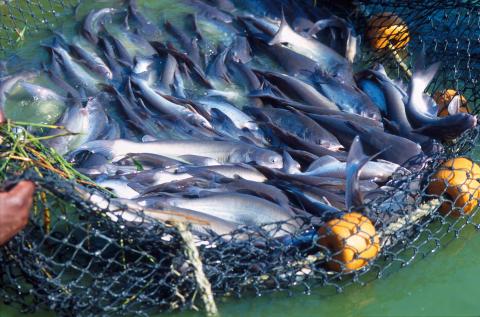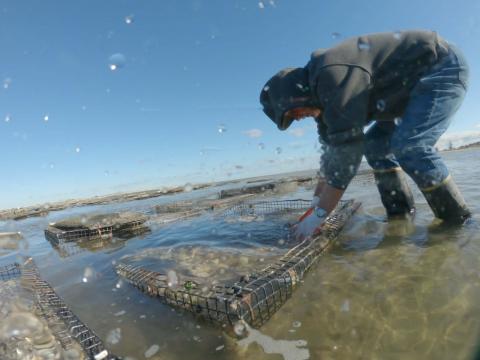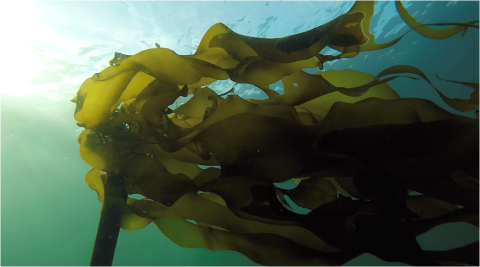Aquaculture is the production of aquatic organisms under controlled conditions throughout part or all their lifecycle. Its development can help meet future food needs and ease burdens on natural resources.
USDA is providing leadership to ensure that a healthy, competitive, and sustainable aquaculture sector can produce an abundant, safe, and affordable supply of seafood products. USDA scientists support and conduct research that develop new aquaculture technologies and systems that maintain healthy ecosystems, evaluate aquatic animal health, and inform consumers on the healthfulness and sustainability of responsible aquaculture production. Our aquaculture research, education, and extension activities also create jobs and train a skilled workforce in rural communities.
The National Science and Technology Council (NSTC) Subcommittee on Agriculture coordinates aquaculture activities with USDA and across the Federal Government. USDA coordinates activities within the Department through its Working Group on Aquaculture to:
- Continually Improve USDA Customer Service to Aquaculture Community; and
- Provide USDA Support for a Federal Economic Development Initiative on Aquaculture.
Aquaculture is Agriculture: USDA’s Role in Supporting Farmers of Fish, Shellfish, and Aquatic Plants
In the fall of 2020, the Research, Education, and Economics (REE) mission area, including the Office of the Chief Scientist (OCS), and the USDA Working Group on Aquaculture provided an opportunity for the domestic aquaculture industry to tell USDA how we can best serve this farming community. The USDA Aquaculture is Agriculture Colloquium drew over 300 participants from industry, academia, state agencies, tribal agencies, and federal agencies. A summary of the priorities identified in the Colloquium by aquaculture stakeholders, federal program managers, the research community, natural resource regulators, and others to help guide future program directions and potential investments may be found in this white paper (PDF, 546 KB).
Seventeen USDA Agencies fall under eight Mission Areas to support aquaculture through their leadership in the following programs. USDA primarily supports aquaculture through the programs administered in the following Mission Areas and Agencies.
- Mission Area: Food Safety
-
Food Safety ensures that the Nation's commercial supply of meat, poultry, and egg products is safe, wholesome, and properly labeled, and packaged. This mission area also plays a key role in the President's Council on Food Safety and has been instrumental in coordinating a national food safety strategic plan among various partner agencies including the Department of Health and Human Services and the Environmental Protection Agency.
Food Safety and Inspection Service (FSIS) protects the public’s health by ensuring the safety of meat, poultry, and processed egg products. Through the 2008 and 2014 Farm Bills, FSIS inspects siluriformes, including catfish, under the Federal Meat Inspection Act.
Contact: Barbara Dwyer, Senior Analyst
- Mission Area: Marketing and Regulatory Programs (MRP)
-
Marketing and Regulatory Programs facilitates domestic and international marketing of U.S. agricultural products and ensures the health and care of animals and plants. MRP agencies are active participants in setting national and international standards.
Agricultural Marketing Service (AMS) administer programs that create domestic and international marketing opportunities for U.S. producers of seafood. AMS also provides the aquaculture industry with valuable services to ensure the quality and availability of wholesome food for consumers across the country.
- Under the 1996 Commodity Promotion, Research and Information Act both the Secretary and Industry Organizations could propose checkoff programs that would support research and/or marketing programs.
- AMS could continue procuring aquacultured commodities for federal nutrition assistance programs.
- AMS could develop organic standards for aquaculture under the National Organic Program.
Contact: Melissa R. Bailey, Ph.D., Associate Deputy Administrator, Livestock & Poultry Program
Animal and Plant Health Inspection Service (APHIS) mission area includes protecting and promoting U.S. agricultural health and administering the Animal Health Protection Act.
- APHIS serves as the lead Federal agency for preventing, controlling, and eliminating aquatic animal diseases and for oversight of aquatic animal health programs. This Act gives the Secretary of Agriculture the authority to regulate imports, exports, and interstate commerce of all animals and their pests/pathogens should they pose a risk to domestic livestock.
- APHIS is the competent authority to lead and negotiate import and export animal health requirements in order to protect domestic livestock and natural resources.
- APHIS houses the Chief Veterinary Medical Officer (CVO) for the U.S who is responsible for reporting detections of all OIE listed pathogens.
- The Secretary has the authority to hold, seize, treat, or prohibit and restrict the movement of any farm-raised animals including those cultured in the exclusive economic zone (EEZ).
Contacts:
Kathleen H. Hartman, Aquaculture Program Leader, Veterinary Services
Alicia R Marston, Live Animal Imports & Exports- Aquaculture Specialist, Veterinary Services - Mission Area: Food, Nutrition, and Consumer Services
-
Food, Nutrition, and Consumer Services works to harness the Nation's agricultural abundance to end hunger and improve health in the United States. Its agencies administer federal domestic nutrition assistance programs and the Center for Nutrition Policy and Promotion, which links scientific research to the nutrition needs of consumers through science-based dietary guidance, nutrition policy coordination, and nutrition education.
Food and Nutrition Service (FNS) administers 15 nutrition assistance programs, spending over $100 billion annually, that leverage America’s agricultural abundance to ensure children and low-income individuals and families have nutritious food to eat. This includes the allowable purchase of seafood by program participants, and working with AMS on the purchase, procurement, and distribution of domestic foods for the domestic feeding programs, including domestic seafood products.
FNS also works with the Department of Health and Human Services (HHS) to publish and promote the Dietary Guidelines; which provides food-based recommendations, including on seafood and seafood products, to promote health, help prevent diet-related chronic diseases, and meet nutrient needs.
Contact: CONTACT US
- Mission Area: Farm Production and Conservation (FPAC)
-
Farm Production and Conservation (FPAC) is the Department’s focal point for the nation’s farmers and ranchers and other stewards of private agricultural lands and non-industrial private forest lands. FPAC agencies implement programs designed to mitigate the significant risks of farming through crop insurance services, conservation programs and technical assistance, and commodity, lending, and disaster programs.
Farm Service Agency (FSA) provides financial support for Aquaculture activities through the following programs:
- Noninsured Crop Disaster Assistance Program (NAP) provides a risk management tool for aquacultural species, not covered by RMA, which are:
- any species of aquatic organisms grown as food for human consumption
- fish raised as feed for fish that are consumed by humans
- ornamental fish propagated and reared in an aquatic medium.
Contact: Chris Vazquez, Section Head Disaster Assistance Section
- The Emergency Assistance for Livestock, Honeybees and Farm-Raised Fish Program (ELAP), provides assistance to eligible farm-raised fish producers for:
- Death losses, in excess of normal mortality, of eligible bait fish or game fish caused by an eligible adverse weather or loss condition incurred in the county where the eligible adverse weather or loss condition occurred; and
- Purchased or produced farm-raised fish feed losses for feed that was intended to be fed to eligible farm-raised fish and was damaged because of an eligible adverse weather or loss condition in the county where the eligible adverse weather or loss condition occurred.
- For more information on ELAP-Farm Raised Fish, please view FSA’s ELAP’s Farm-Raised Fish Fact Sheet (PDF, 529 KB).
Contact: Amy Mitchell, Program Manager
- Direct Farm Loans are available for those operations that produce eligible aquatic organisms for food.
- Direct Farm Ownership (FO) provide assistance to eligible aquaculture operations to purchase real estate for land based operations. Loan can be made in participation with other lenders, as a downpayment or the full purchase price if no more than the maximum loan amount, which is currently $600,000. Loan terms can go to a maximum of 40 years but are based on loan type and repayment ability.
Direct Operating Loans (OL) are for the purchase of equipment and supplies necessary to run an aquaculture operation. The length of time is determined by the type of security and the repayment and may be from one to seven years. - Guaranteed Farm Ownership and Operating Loans are loans made by local lenders for similar purposes as the Direct Loans. The loans have higher limits than those made by FSA Directly and are backed up to 95% by FSA against loss.
- Direct Farm Ownership (FO) provide assistance to eligible aquaculture operations to purchase real estate for land based operations. Loan can be made in participation with other lenders, as a downpayment or the full purchase price if no more than the maximum loan amount, which is currently $600,000. Loan terms can go to a maximum of 40 years but are based on loan type and repayment ability.
Contact: Bill Cobb, Deputy Administrator for Farm Loan Programs
The Farm Storage Facility Loan (FSFL) Program provides low-interest financing for aquaculture producers to build, upgrade, or acquire, permanently affixed or portable, new or used farm storage and handling facilities, equipment and handling trucks to store and handle eligible commodities they produce. FSFLs may also be used to purchase storage and handling trucks and/or equipment for maintaining and monitoring the eligible commodity. Aquaculture species, for FSFL purposes, are defined as any species of aquatic organisms grown as food for human consumption, or fish raised as feed for fish that are consumed by humans. For more information on the FSA FSFL Program, please view the Fact Sheet (PDF, 270 KB).
Contact: Toni Williams, Program Manager
Natural Resources Conservation Service (NRCS) provides technical expertise, conservation planning, and financial assistance for farmers, ranchers and forest landowners wanting to make conservation improvements to their land.
Technical assistance for aquaculture producers is provided in the areas of:
- Agriculture Engineering for aquaculture infrastructure,
- Water Quality technical assistance for both clean water inputs and nutrient management outputs,
- Energy Conservation Engineering,
- Water Management Engineering for water conveyance systems, and
- Wildlife enhancement – both terrestrial and aquatic opportunities.
Contact: Jan Surface, National Water Quality Specialist/Aquatic Ecologist
Financial assistance for eligible aquaculture producers is provided through a variety of programs, including:
- The Environmental Quality Incentives Program (EQIP) provides financial and technical assistance to agricultural producers to address natural resource concerns and deliver environmental benefits such as improved water and air quality, improved or created wildlife habitat, and mitigation against increasing weather volatility.
- Conservation Innovation Grants (CIG) are competitive grants that drive public and private sector innovation in resource conservation. CIG projects inspire creative problem solving that boosts production on farms, ranches, and private forests - ultimately, they improve water quality, wildlife habitat, and other resource concerns.
- The Regional Conservation Partnership Program (RCPP) promotes coordination of NRCS conservation activities with partners that offer value-added contributions to expand our collective ability to address on-farm, watershed, and regional natural resource concerns. Through RCPP, NRCS seeks to co-invest with partners to implement projects that demonstrate innovative solutions to conservation challenges and provide measurable improvements and outcomes tied to the resource concerns they seek to address.
Contact: Gene Kim, Natural Resource Specialist
Risk Management Agency (RMA) provides insurance policies to help aquaculture producers manage risk. Currently RMA offers three insurance products for aquaculture producers.
- Group Risk Plan (GRP) Oysters. This program is a risk management tool to insure against widespread loss of production of oysters in a county. GRP Oysters is currently available in 9 counties in Louisiana.
- Aquaculture Dollar Plan Clams. This program provides inventory-based stock mortality insurance for clam producers in select counties in Massachusetts, South Carolina and Virginia.
- Whole-Farm Revenue Protection (WFRP). WFRP provides a risk management safety net for all commodities on the farm under one insurance policy. The whole-farm revenue protection plan is available to alligator, baitfish, clams, fish, oysters, trout, aquatic plants, and watercress producers across the country.
You may view a fact sheet with information on RMA’s insurance policies for aquaculture producers.
Contact: Alexander Sereno
- Noninsured Crop Disaster Assistance Program (NAP) provides a risk management tool for aquacultural species, not covered by RMA, which are:
- Mission Area: Trade and Foreign Agricultural Affairs (TFAA)
-
Trade and Foreign Agricultural Affairs' (TFAA) role is to provide our farmers and ranchers with opportunities to compete in the global marketplace. TFAA is the Department’s lead on trade policy with primary responsibility to ensure USDA speaks with a unified voice on international agriculture issues domestically and abroad. Within TFAA, the Foreign Agricultural Service is the lead U.S. agency tasked with promoting exports of U.S. agricultural products through market intelligence, trade policy, trade capacity building, and trade promotion programs. This work is carried out by staff in Washington as well as a global network of 93 offices covering 171 countries. Also within TFAA, the U.S. Codex Office coordinates U.S. participation in the Codex Alimentarius Commission, a United Nations body that sets international food standards while protecting consumer health and ensuring fair trade practices.
Foreign Agricultural Service (FAS) links U.S. aquaculture to the world to enhance export opportunities and global food security. FAS supports activities that benefit the shellfish industry and by extension the aquaculture segment, mostly via state run trade organizations.
Contact: CONTACT US
- Mission Area: Research, Education, and Economics (REE)
-
Research, Education and Economics is dedicated to the creation of a safe, sustainable, competitive U.S. food and fiber system, as well as strong communities, families, and youth through integrated research, analysis, and education.
National Institute of Food & Agriculture (NIFA) addresses national needs for aquaculture research, education, extension, and technology transfer to support U.S. aquaculture production through:
- The Regional Aquaculture Center (RAC) program, established by statute in 1985.
- Funding aquaculture extension educators via Cooperative Extension at Land Grant Universities.
- NIFA’s research investment addresses diverse freshwater and marine aquaculture research areas and species.
Contact:
Amrit Bart, National Program Leader
Timothy Sullivan, National Program LeaderEconomic Research Service (ERS) anticipates trends and emerging issues in agriculture, food, the environment, and rural America and to conduct high-quality, objective economic research to inform and enhance public and private decision making. ERS provides monthly data on the domestic aquaculture industry and U.S. trade in aquaculture products.
Contact: Christopher Davis, Agricultural Economist
National Agricultural Statistics Service (NASS) conducts both the Census of Agriculture and the Census of Aquaculture, which provide comprehensive pictures of the aquaculture sector at the state and national levels every five years. Annually, NASS also publishes three aquaculture reports: The February Catfish Production Report, the July Catfish Processing Report and the February Trout Production Report.
Contact: Jean N. Porter, Poultry and Specialty Commodities Section
Agricultural Research Service (ARS) conducts intramural research and delivers technologies that improve domestic aquaculture production efficiency, animal health nutrition, genetic improvement and product quality while minimizing impacts on natural resources. Current research includes shellfish and freshwater and marine finfish farmed across a diverse array of production systems. Research is conducted under National Program 106 Aquaculture.
Contact: Caird Rexroad, National Program Leader for Aquaculture
- Mission Area: Rural Development (RD)
-
RD helps improve the economy and quality of life in rural America through loans, grants and loan guarantees to help create jobs and support economic development and essential services. RD also promotes economic development by supporting loans to businesses through banks, credit unions and community-managed lending pools. RD offers technical assistance and information to help agricultural producers and cooperatives get started and improve the effectiveness of their operations. Finally, RD provides technical assistance to help communities undertake community empowerment programs.
Rural Business Cooperative Service (RBS) offers programs to help businesses grow as well as job training for people living in rural areas. These programs help provide the capital, training, education and entrepreneurial skills that can help people living in rural areas start and grow businesses or find jobs in agricultural markets and in the bio-based economy.
Rural Housing Service (RHS) offers a variety of programs to build or improve housing and essential community facilities in rural areas. RHS offers loans, grants and loan guarantees for single- and multi-family housing, childcare centers, fire and police stations, hospitals, libraries, nursing homes, schools, first responder vehicles and equipment, housing for farm laborers and much more.
Rural Utilities Service (RUS) provides financing to build or improve infrastructure in rural communities. This includes water and waste treatment, electric power and telecommunications services. These services help expand economic opportunities and improve the quality of life for rural residents.
Contact: CONTACT US



